I have to say I was a bit disappointed. The yellowfin tuna was kind of dry and mealy in texture exactly like the frozen block we can get any time from our local Japanese grocery store (I should not have expected more). The wild caught hamachi was not bad but, as they cautioned, it was not as oily and lean. (Maybe this was because it is spring and they haven't had the summer to fatten up? I like frozen hamachi better.) The amaebi were too big; only two were the size I like but the remaining 3 were very large with lots of roe. The uni tasted good but it was very soft and color was not as nice as the highest grade "gold" uni we are used to.

The sashimi servings we had the first night are shown above. We felt guilty after seeing all the roe these prawns had. Rather than wasting them (they are attached to the outer layers of the shell of the abdomen not to the meat), I removed and sautéed them in butter and seasoned with soy sauce in a small frying pan. I let them cool down and served them in a cucumber cup (left in the picture above--the one looking darker red) with tobiko roe (bright red on the right). It is more about the texture than taste but not bad for a fringe benefit.
Saturday, April 21, 2012
Non-frozen yellowfin tuna, yellowtail and amaebi sashimi with roe キハダマグロ、はまち、甘エビの刺身
Catalina has not had bluefin tuna, either "Akami" or "Toro", for a long period of time but almost always has fresh sashimi "Yellowfin" tuna キハダマグロ listed as in-stock. I decided to try the fresh yellowfin tuna as well as fresh wild caught yellowtail or Hamachi ハマチ. They also had "live" side spotted prawn or "amaebi" 甘エビ (more like "botan-ebi" 牡丹海老). The only uni they had was "Premium" not "Gold" uni. I decide to give it a go and ordered these items.
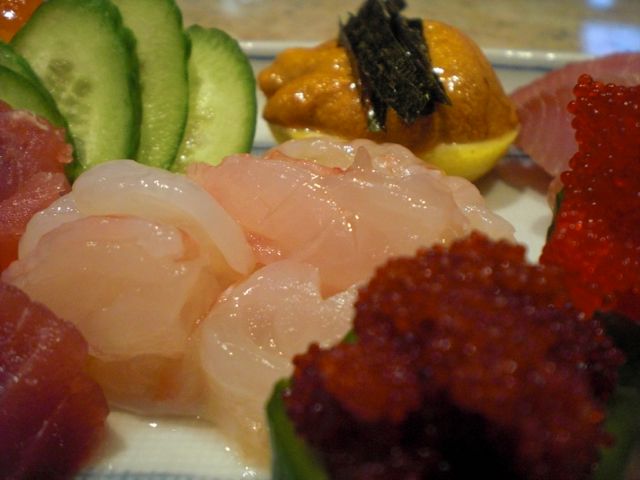
I served the amaebi more like lobster sashimi (cut-up) since it was so large. This time they arrived all dead but they were still fresh enough. The meat was succulent and sweet as you can see in the above picture.

I used two small and one large amaebi for two of us. After I deep fried the shrimp heads, I cut the large one in half. The small ones we could enjoy everything including the shells which became crunchy. But with the large one, the outer shell was too hard even after prolonged frying and we consumed only what was inside. It was like eating crackling--very crunchy with a pleasant ocean flavor. It is the best part in any case.
Thursday, April 19, 2012
Ragu of lamb with chickpeas 子羊とひよこ豆のラグー
Recently, I stumbled into a nice blog by Marc Matsumoto. His recipes span many different food cultures and his food pictures are very nice (he is a professional food photographer and his recipes are occasonally featured on the PBS website). His pictures look professional--not like mine which are done quickly using a point-and-shoot camera (we tend to be hungry before the photo-shoot and cannot afford to devote too much time to it). In any case, you can see some influence from his pictures. I am using a lower angle and taking advantage of the shallow field of focus (see the second picture, Whuuuum, the focus is not really sharp. I blame it to my small point-and-shoot camera.)
In any case, this is based on his recipe but I took a few shortcuts and modifications and I decided to call it a "Ragu". Please refer to the original recipe for a more authentic "Braised lamb with chickpeas" but the end result was pretty good and satisfying.
Lamb: Instead of a whole shoulder of lamb, I used cubed stew lamb meat which is also from the shoulder (1 lb).
Lamb: Instead of a whole shoulder of lamb, I used cubed stew lamb meat which is also from the shoulder (1 lb).
Spices: I deviated a bit from Marc's recipe. I used cumin (2 tsp), Garam masala (1 tsp), Kosher salt (1 tsp), black pepper (1 tsp), brown sugar (1 tsp) and curry powder (1/2 tsp). Curry powder is my addition and I did not have "Pomegranate molases" which was called for in the original recipe.
I placed the spices in a Ziploc bag and put in the meat. I shook the pieces well to coat. I placed it in a refrigerator removing as much air as possible from the Ziploc bag. I planed to cook this soon after I started marinating it but it ended up sitting in the fridge in the meat compartment for 4 days (probably several hours or overnight would suffice). I was expecting some juice to develop after 4 days but no excess liquid came out. In the original recipe, this was cooked in a 250F oven for a long time but I chose to just cook it on the stove.
Vegetables: Onion (1 large, finely chopped), garlic (4 fat cloves, finely chopped) and Garbanzo beans (8oz can). The original recipe calls for dried Garbanzo beans but I took a shortcut here and used pre-cooked canned Garbanzo beans.
In a deep pot, I first added olive oil (2 tbs) and when the oil was hot and shimmering, added the cubes of lamb. After few minutes, I tuned the meat to brown the other side. I could really smell all the spices at this point. After the meat was seared, I removed the pieces to the plate and set aside. The bottom of the pot developed a brown crust (fond). I added the onion and garlic and sautéed. The moisture from the onion and the use of a silicon spatula helped to dislodge the "fond". I sautéed until onion was soft, semitransparent and garlic fragrant (5 minutes or so). I put back the meat and poured chicken broth to cover (about 1 cup). I placed my Ms Piggy silicon "otoshi buta" lid and the regular lid of the pan askew to encourage evaporation. I simmered this for over an hour. I let it come down to room temperature and placed it in the refrigerator.
The next day, my wife tookover before I came home. She removed the otoshi-buta and added the drained garbanzo beans and simmered it for 30-40 minutes. After I came home, I separated the meat and the beans. I placed the meat in a small bowl and, using a large spoon, shredded the meat (it was very tender and easy to shred by just pressing on the pieces with the edge of the spoon). I kept the remaining liquid simmering to reduce (probably less than 1/4 cup at the end). I mixed the shredded lamb and garbanzo beans into the reduced liquid. One of the problems with slow prolonged cooking is that all the tastes become muted and a bit tired. So, it is important to add fresh herbs at the end. I added fresh parsley (5-6 sprigs stems removed and finely chopped) and several grinds of freshly cracked black pepper. Just before serving, I garnished it with fresh mint (4-5 sprigs, stems removed and finely chopped). Instead of flat bread as suggested in the original recipe, we cooked up Pennsylvania Dutch egg noodle as the starch.
This is a very satisfying dish. Although the lamb flavors are muted in long cooking with the spices, the parsley and mint added fresh bright notes. The meat was very tender but not dry and the texture of meat and the Garbanzo beans go very well together. With a glass of good red wine, this cannot go wrong.
Tuesday, April 17, 2012
Barbecued Rolled leg of lamb 子羊のもも肉のバーベキュー
Since it was Easter and my wife loves lamb, we decided to have a lamb barbecue. I saw a relatively inexpensive (especially compared with the rack of lamb) leg of lamb (bone-in), I decided to make a rolled leg of lamb cooked in our usual Weber kettle. Often, we butter-fly a leg of lamb since it is quicker and easier to cook and the exposed surface will be well cooked. Even if we buy a previously deboned and rolled leg of lamb, I remove the trussing and open it up. I do this because I cannot know how much exposure the meat has had to the environment while it was being prepared at the store. When it is rolled the exposed surface gets tucked inside the roll and often is not fully cooked especially if it is cooked to be slightly pink inside. If I debone and roll it myself, I know the inner surface was not exposed to the environment much before it was rolled.
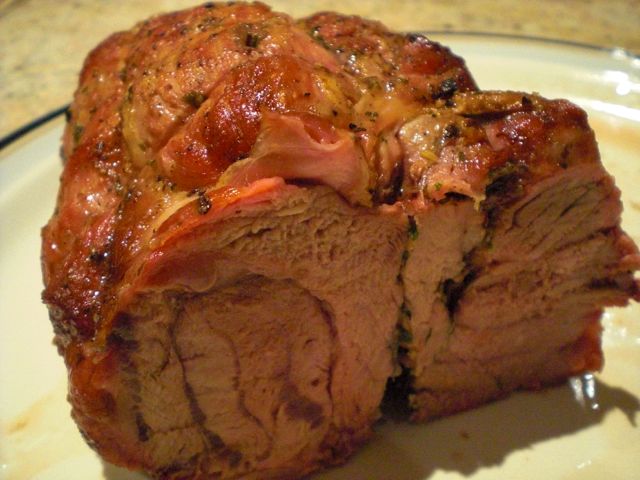
Lamb: This was bone-in leg of lamb and was around 4 lb with bone (I think). I did a bit of surgery to removed the bone (including the knee joint). I cleaned the sliver skin, excess fat and fibrous tissue around the joint.

The smell of the garlic, lemon, and roasted lamb wafted throughout the kitchen while we were preparing for the side dishes of onion and sweet potatoes. The vegetables were all prepared by my wife including roasted carrot with tarragon and green beans. I think she added butter, soy sauce and a splash of sushi vinegar to the onion and just butter and soy sauce to the sweet potatoes.
Seasoning: I could have stuffed the leg but I decided to make it simply. I made a mixture of parsley (6-7 sprigs, stalks removed and finely chopped), garlic (3 fat cloves, finely chopped), lemon zest (1 large, zest removed using a micrograter, about 2 tbs).
I seasoned the inside of the lamb (the portion that used to face the bone) with black pepper and salt and smeared the parsley mixture and rolled. Using butcher's twine, I trussed it to make a neat cylinder. I rubbed the surface with olive oil and then seasoned rather severely with black pepper and Kosher salt.
I cooked this in the Weber kettle using indirect heart like I do with whole chicken. I did not use wood chips so that the delicate flavor of the lamb and the parsley/lemon zest seasoning would come through better. As usual, we wrapped sweet potatoes and whole onions in aluminium foil and put them on the grill around the meat. After 45 minutes, I inserted the temperature probe in the middle of the thickest part of the meat and cooked another 15-20 minutes or until the thermometer registered 140F (for medium). I cooked a bit more than I would have liked. I removed the meat to a plate and covered it with aluminum foil and let it rest for 10-15 minutes.
Fresh lemony and garlicky flavors with still fresh tasting parsley were wonderful. I usually use rosemary for the lamb, but without rosemary, it is more delicate tasting. The sweet potatoes were particularly sweet. (I asked my wife if she added any sugar and she said no, all the sweetness came from the potato itself).
 Of course, the libation has to be a good red. We were having Gundlach Bundschu Carbernet Souvignon 2007. Initially when we tasted this without food, we thought it was a bit muted. With the lamb, it really tasted better. It is not one of these fruit and vanilla-laden kind but subtle complex black fruit, earthy spices with good minerality were coming through. This is obviously not a sipping wine but a very decent food wine.
Of course, the libation has to be a good red. We were having Gundlach Bundschu Carbernet Souvignon 2007. Initially when we tasted this without food, we thought it was a bit muted. With the lamb, it really tasted better. It is not one of these fruit and vanilla-laden kind but subtle complex black fruit, earthy spices with good minerality were coming through. This is obviously not a sipping wine but a very decent food wine.
Sunday, April 15, 2012
Easter breakfast; whole wheat cross bun and scrambled egg イスーターの朝ごはん
Although this is obviously not Izakaya item, the creamy scrambled egg with shiitake mushroom and asparagus is a perfect dish as a drinking snack. My wife is into making all kinds of bread (taking over most of what I used to bake and going further) especially whole wheat breads. She baked hot cross buns for Easter breakfast this time. Instead of the usual sweet sugar-laden icing, she made it from cream cheese and milk with much reduced sugar.

I have to ask my wife to provide recipes for the whole wheat hot cross buns and icing.
For two servings;
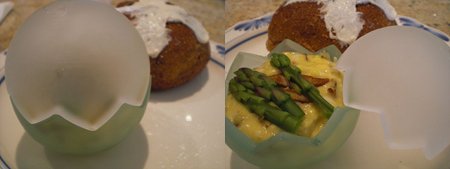
I used egg-shaped small glass containers as you see on the left of the above image. On the right of the image above, the lid was open revealing the contents. I garnished it with slices of shiitake mushroom (sautéed) and asparagus tips (microwaved and cut in half lengthwise).
The recipe comes from Laurel Robertson's cookbook "The Laurel's Kitchen Bread Book". Of course the recipe I used varied somewhat from the one in the book. For the bread: Raisins and chopped dates (2 cups total), 1 cup walnuts toasted and then rubbed in a towel to remove the bitter tasting brown skin. 2 Tsp dry yeast, 1/2 cup warm water (to proof the yeast), 6 cups whole wheat flour, 2 tsp salt, 2 large eggs, 3 tbs honey, 1 cup hot water, 1 cup cold buttermilk. I added the salt, the honey and hot water to dissolved the honey and salt. I let it cool down. I proofed the yeast. Using a mixer (Kitchen Aid - Professional 5 - with a dough hook), I then I added the yeast, honey and salt mixture and cold buttermilk to 4 cups of the wheat flour. I then added more wheat flour 1/2 cup at a time until the mixture started to form a dough. Then I added the eggs. I continued to add more flour 1/2 cup at a time until the dough formed on the dough hook and pulled away from the sides. I then added 1/4 cup butter cut into small slices. I continued kneading after the butter was fully incorporated for another 7 to 10 minutes. For the last few minutes of kneading I added the dried fruits and nuts. I removed the dough from the bowel did a few rounds of hand kneading and then put into a bowel coated with about 1/2 teaspoon of oil to keep the surface moist during the first proofing. I deflated the dough and let it rise again. After it doubled in size I deflated it again and formed it into small round balls. I put the balls in a heavily greased glass Pyrex baking dish slightly separated but close enough so that the buns would touch after rising (I'm not wild about a lot of crust on these types of buns). After they doubled in size I put them into a 400 degree oven for 20 minutes.
Icing: I used one block of 1/3 less fat Philadelphia cream cheese, 1 tsp butter, 3 tsp honey 1/2 tsp cinnamon, and 2 tsp of milk. Using a mixer, I softened the cream cheese and butter. When it was creamy I added the honey and cinnamon and kept mixing. I added just enough milk to make the mixture a spreadable consistency.
She asked me to make something goes with the hot cross buns for breakfast. I made creamy scrambled egg with shiitake mushrooms garnished with asparagus tips. If I had, I would have made this with black truffle but no such luck this time. I made the scrambled eggs very soft and creamy by using a double boiler or "bain marie". Since I will not totally cook and harden the eggs, I used pasturized eggs with the addition of cream.
I sautéed fresh shiitake mushroom (4, medium sized stem removed and finely chopped) and shallot (1, medium, finely chopped) in butter (2 tsp) until soft (several minutes) seasoned with salt and freshly cracked white pepper and set aside to cool.
I beat the eggs well and strained them to remove any clumps of egg white and chalaza (3, pasteurized eggs) which will make an unpleasant congealed hard spot in an otherwise creamy scrambled eggs; situation similar to making "chawanmushi" 茶碗蒸し.
On a bain marie (gently simmering hot water), I melted butter (1 thin pat, less than1 tsp) and when the butter melted, I added the beaten eggs and the sautéed shallot and shiitake mushroom. I gently mixed it with a silicon spatula while scraping the bottom and the sides. After few minutes, eggs started to congeal. I added salt and freshly cracked white pepper and mixed more vigorously until it was cooked but nicely creamy. I took the pan from the bain marie just before it reached the desired doneness and kept stirring.
I used egg-shaped small glass containers as you see on the left of the above image. On the right of the image above, the lid was open revealing the contents. I garnished it with slices of shiitake mushroom (sautéed) and asparagus tips (microwaved and cut in half lengthwise).
The creamy scrambled eggs were infused with the shiitake flavor. The slow cooking over the bain marie and the addition of cream and butter made the scrambled eggs like soft custard. The hot cross buns were also excellent. They had the nice nutty flavor of whole wheat that combined well with the roasted walnuts, dates and raisins. The icing was not too sweet but had rich flavor that complemented the buns--a great combination.
Friday, April 13, 2012
American Wagyu New York strip steak アメリカ和牛のニューヨークストリップステーキ
Wagyu 和牛 is a breed of cattle developed in Japan (As I understand it they are a cross between Japanese native and western cattle. Reportedly, only a few pure native Japanse cattle remain in Kagoshima 鹿児島 and Yamaguchi 山口 prefectures). The breed was selected for its highly marbled meat. To us, classic Japanese Wagyu beef is too fatty when eaten as a steak but it is considered one of the most prized beef. When eaten raw, it has a mouth feel reminiscent of fatty tuna but once cooked it tastes a bit too fatty to me. Beef fat has a strong taste to me particularly when in excess (unlike pork fat which can be eaten to any excess as far as I am concerned). Dependining on the regions of Japan in which a particular breed was developed, it is named, for example, "kobe-gyu" 神戸牛, "Matsuzaka-gyu" 松坂牛 or "Oumi-gyu" 近江牛. Often, this beef is served thinly sliced for grilling (yakiniku 焼肉) or sukiyaki すき焼き.
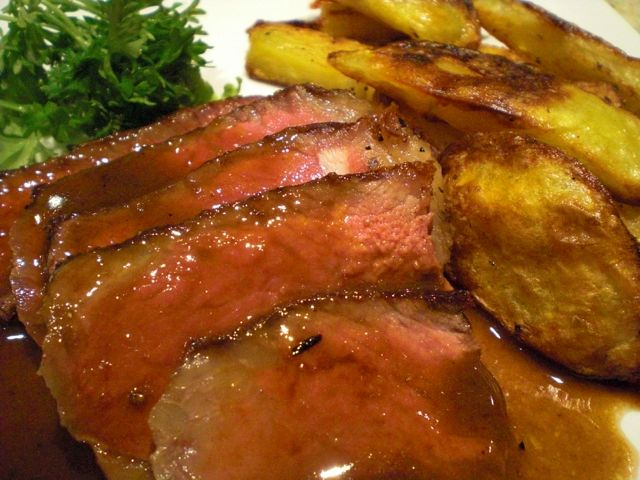
In the U.S., one could get genuine wagyu beef imported from Japan but it is prohibitively expensive (we never tried it). It is not worth it in my book. Instead, like ones raised in my nice's farm, American wagyu (cross between Wagyu and Black Angus) is raised in US and Australia and its meat is widely sold in a gourmet market at a reasonable (relatively speaking) price. The meat is much redder and not as highly marbled compared to genuine Wagyu beef as you can see in the picture below but it is much fattier and marbled than typical American prime or choice beef. The cut I got this time was New York strip steak and I bought it as one serving. It weighed almost 1lb! (Between two of us we ate only less than half this evening).

I did not do anything special to cook the steak. I first let it warm up to room temperature and seasoned it with Kosher salt and freshly cracked black pepper. Using a small amount of light olive oil, I seared both sides on medium high flame until a nice brow crust was formed (The above image on the right). I finished it in a 350F oven for 8 minutes (for medium rare as you can see below). I removed the steak from the pan to a plate and covered loosely with aluminum foil to let it rest for 10 minutes. It was homogeneously pink without the center being totally raw. The marble lines were almost not visible since the fat became semitransparent but it was there.
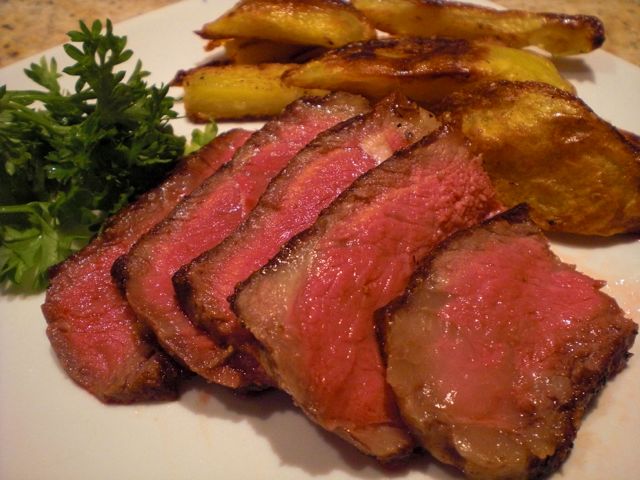
I served it sliced with the side of oven fried potato. For sauce, I degrazed the pan with sake (4-5 tsp) and reduced it to 1/3 and added soy sauce (1 tsp). I then added 4-5 pats of butter to make an emulsion. Off heat, I added real wasabi (1/2 tsp) and poured it over the slices of steak (the first picture).
This was certainly a great steak. (Of course, it was perfectly cooked, if I do say so myself). The wasabi flavor did not come through as much as I expected. Is it better than U.S. prime stake? I am not so sure. The oven fried potatos were excellent. They had a crunchy crust and creamy soft inside (my wife's contribution). We were still enjoying the wonderful 2007 Caymus Cabernet Sauvignon with this steak.
My niece married into a family of cattle farmers near Sapporo. They raise Wagyu but I was told they mostly raise the cross between Wagyu and black Angus. I learned from my niece and her husband that the wagyu is rather delicate and has to be housed in a barn during the cold snowy season but the cross breed with black Angus is much more robust and can stay outside in the snow and survive (and thrive).
This was certainly a great steak. (Of course, it was perfectly cooked, if I do say so myself). The wasabi flavor did not come through as much as I expected. Is it better than U.S. prime stake? I am not so sure. The oven fried potatos were excellent. They had a crunchy crust and creamy soft inside (my wife's contribution). We were still enjoying the wonderful 2007 Caymus Cabernet Sauvignon with this steak.
Wednesday, April 11, 2012
Pork belly braised in miso sauce 味噌味豚の角煮
Fresh pork belly used to be difficult to get in the past but with the opening of the new gourmet grocery store near us, we now can get pork belly any time. Japanese (including me) somehow love this portion of the hog. Thinly sliced pork belly (like bacon) is called "bara-niku" バラ肉 or "sanmai-niku" 三枚肉 and is widely used in Japanese dishes. But the ultimate is "Butano-kakuni" 豚の角煮 which I have posted several iterations made from pork spare rib, salted pork, and a block of a genuine pork belly. Since we happened to shop in this gourmet grocery store the other day, we bought some pork belly along with fresh whole fish.
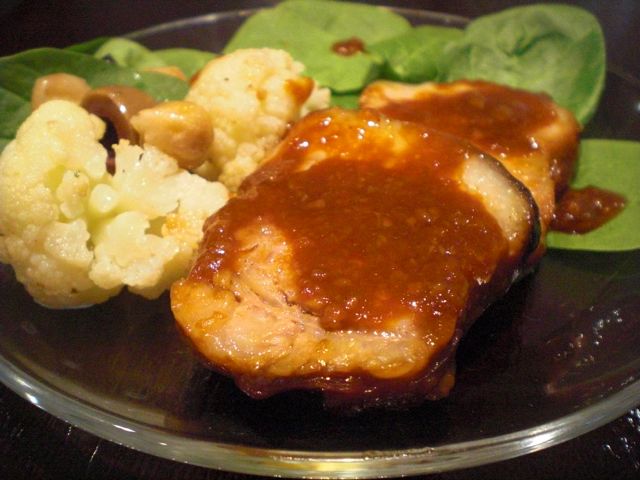
I pondered what to make and decided to make a variation of "Kaku-ni" that is miso flavored. This is inspired by a recipe I read but I made substatinal changes since just reading the recipe, I could imagine the meat would not be that tender and the braising sauce would be too salty as well as too sweet. Pork belly requires a long time cooking especially if it is cooked as a block rather than thinly sliced. So I borrowed the idea of using a braising miso sauce from the recipe I read but deviated substantially and made this dish as though making "Kaku-ni" in a more traditional way by pre-boiling it in water (more traditional as compared to what I posted before as "Kakuni").
The 1 pound of pork belly which I bought will easily serve 8-10 of the small servings pictured above.
I first cut the pork belly block in half so that it would fit better in the pot. I boiled it in enough water so the pork was covered "comfortably". I added scallions (2, cleaned and light bruised including the green parts), ginger root (thinly sliced , 5-8 slices), and raw rice (1 tsp). I placed the pork belly in the cold water and put the pot on a medium flame. When It started boiling, I turned down the flame to simmer and skimmed off any scum that appeared on the surface (#1). I simmered it for over 1 hour with the lid on. I then washed the prok belly in cold running water and put it in a tight fitting (relatively speaking) baking dish (I used a small Pyrex baking dish with a glass lid) (#2).

Sauce/Marinade: The amount of the marinade has to be varied depending on the size of the baking dish. To accommodate the baking dish I used the marinade consisted of miso (2 tbs), mirin (4 tbs) and soy sauce (2 tbs). As I mixed the miso into the liquid, I added a bit more mirin to make it a saucy consistency. I did not add sugar but I could have added sugar to make it sweeter. (I thought the Mirin was plenty sweet).
 This is as good as the more traditional pork belly kaku-ni. The fat layer melted in the mouth and was very sweet. The meaty portion had a good but tender consistency and porky flavor. The miso marinade became nice nutty, salty and sweet sauce. Since this is a rather deadly dish, portion control was an order and I only served three slices per person.
This is as good as the more traditional pork belly kaku-ni. The fat layer melted in the mouth and was very sweet. The meaty portion had a good but tender consistency and porky flavor. The miso marinade became nice nutty, salty and sweet sauce. Since this is a rather deadly dish, portion control was an order and I only served three slices per person.
I poured the marinade over the meat put a lid on and placed it in the refrigerator for several hours (or overnight) turning several times (or I could have used a Ziploc bag, with the air squeezed out). Just before putting it into the oven, I added scallion (3, cleaned and cut into 2-3 inch length) and pickled ginger (10, julienned, which added some sweet and sour ginner taste) (#3).
I pre-heated the oven to 350F. I cooked the pork belly with the lid on for 1 hour occasionally basting with the marinade. After one hour, I removed the lid and continued baking for 30 more minutes basting several times (#4). The marinade became dark brown and thick. If needed, add water during the baking/braising (I did not).
I sliced it in half inch thick pieces and served it with additional sauce on the top on the base of baby spinatch and a side of baked cauliflower and garbanzo beans.
Although sake would be my usual choice of libation, sturdy red wines will go very well. Actually, we were having this with 2007 Caymus cabernet sauvignon. This is one of our favorite wines. It has a nice dark chocolate mingling with complex predominantly black fruit. Hoping that the red wine would lessen the ill-effect of pork belly fat while experiencing hedonistic pleasures in two ways; pork fat and good wine.
Monday, April 9, 2012
Veal Chops with Shiitake Dashi 子牛のチョップのシイタケソース添え
I am digging out old food pictures here. I volunteered for recipe testing over a year ago when Chef Tadashi Ono and Japanese food report fame Harris Salat were preparing the Japanese grill cookbook. I tested a few meat dishes and side dishes.
I thought this was a rather nice dish. The sauce is nicely earthy with a Japanese touch. Veal chop are not usual cuts of meat I use. I was told that I could blog this after the publication of the cookbook. The book was published sometime ago and I bought a copy myself. Since I am running short of something to post I decide to post this dish.
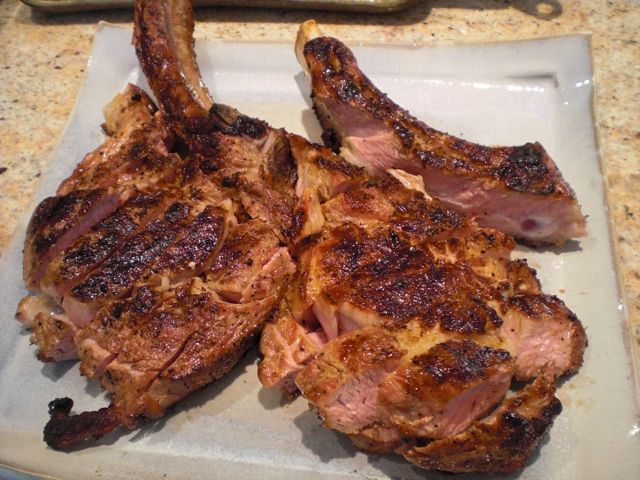
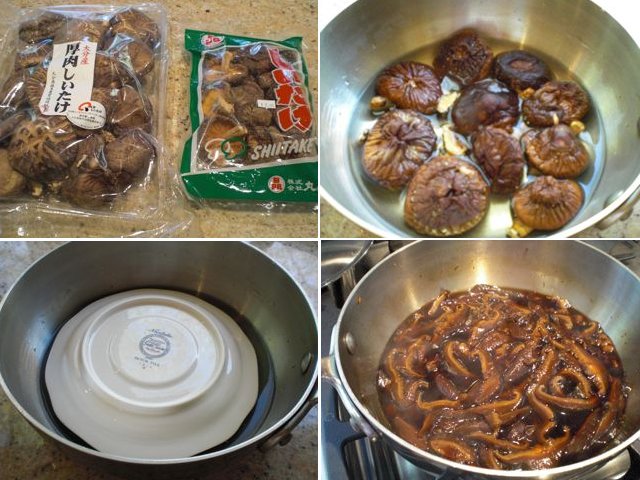 I am trying to remember what this tasted like. When I tasted the sauce by itself, I thought it was too salty and strong. But once it was poured over the cooked veal chops, it was just right amount of saltiness. The sauce added a very nice "umami"-laden mushroom flavor. When I did this, I invited 2 couples (non-Japanese) and asked them to taste and give us feedback. I think this was very well received.
I am trying to remember what this tasted like. When I tasted the sauce by itself, I thought it was too salty and strong. But once it was poured over the cooked veal chops, it was just right amount of saltiness. The sauce added a very nice "umami"-laden mushroom flavor. When I did this, I invited 2 couples (non-Japanese) and asked them to taste and give us feedback. I think this was very well received.
This is the instruction I received. I did not compare the final recipe with this one.
Serves 4
For the shiitake dashi:
12 whole dried shiitake mushrooms, about 1/2 ounce
1 cup water
1/2 cup sake
1/2 cup soy sauce
2 tablespoons mirin
1 tablespoon corn starch
1 tablespoon water
4 veal chops, about 4 pounds
Salt
Freshly ground pepper
To make the shiitake dashi: Add the shiitake and water to a saucepan and let it soak for 4 hours at room temperature. Transfer the shiitake to a cutting board, without discarding the water in the saucepan, and thinly slice the mushrooms. Return the mushrooms to the liquid in the saucepan. Add the sake, soy sauce and mirin to the saucepan, and bring it to a boil over medium heat. Lower the heat so the liquid simmers, and cook for about 15 minutes, until the liquid reduces by 1/3. Skim off any scum that appears on the surface. While the dashi simmers, mix together the corn starch and water in a small bowl, and set aside. When the dashi has reduced, remove the saucepan from the heat. Add the corn starch mixture, and stir until the dashi thickens. Let the dashi come to room temperature.
Use a meat pounder or mallet, or the side of a heavy knife or cleaver, to pound the veal chop 6 times, to flatten and condense the meat. (Be careful not to strike the bone.) Season with salt and black pepper on all sides of the chops. Slap the sides of the veal with your palm, so the pepper sticks to the meat.
Preheat a grill to medium-hot heat. Grill the chops for about 5 minutes on each side for medium rare. When the chops are done, the bone will stick out, as the meat along it shrinks, and the veal will become richly caramel colored. Test for doneness using the nick and peek method. Let the chops rest for about 3 minutes. Drizzle 2 tablespoons of shiitake dashi over the veal chops, and serve.
Other uses for shiitake dashi: Drizzle over steaks and burgers. The dashi can keep in the refrigerator for 3 weeks, and also freezes well.
The picture below is just showing the dried mushroom on the left upper image. The quality of dried mushroom could be quite different from brand to brand. I rehydrated the dried mushroom by placing the small plate so that the mushrooms are completely submerged. The right lower image is the final Shiitake dashi sauce. I did not take the picture of pork chops with this sauce on it.
Subscribe to:
Comments (Atom)


